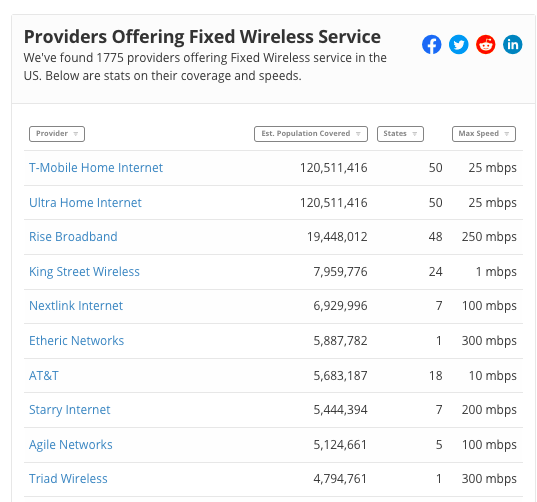Both T-Mobile and Verizon have made quite a big deal about their new fixed wireless access (FWA) offerings. They’re tapping unused capacity on their nationwide wireless networks to offer FWA for home broadband. These offerings will help to provide broadband in underserved areas, and they also give T-Mobile and Verizon a means to steal share from wired telco and cable providers.
At the end of December 2021 T-Mobile had 646,000 home internet customers, and Verizon had about 223,000 subs.
But AT&T has been relatively quiet on the topic of FWA for the past couple of years.
Therefore, it was surprising when Wave7 Research sent a new FWA report, showing that AT&T is among the top 12 fixed wireless providers in the U.S. The Wave7 report was based on numbers from BroadbandNow, which indicate that AT&T’s FWA offering covers 5.7 million people. (See BroadbandNow's chart below).

According to Chris Sambar, AT&T Executive Vice President of Technology Operations, the carrier has over 500,000 fixed wireless subscribers. “We’re no stranger to fixed wireless,” he said.
AT&T offers an FWA point-to-point service, similar to that provided by wireless internet service providers (WISPs) where a device is installed on the outside of the customer’s home, which receives a signal from a nearby FWA transmitter. And AT&T also offers an FWA point-to-multipoint service with a device in the home that receives the mobile signal from its macro network.
RELATED: Is FWA from big carriers different than FWA from WISPS?
AT&T serves both residential and business customers with its FWA. Sambar said most of AT&T’s FWA customers are actually outside of its LEC footprint.
He said AT&T is planning an FWA announcement for later this year, but he wouldn’t provide any specifics now, other than to say it would offer more choice.
Fixed wireless has warts
However, he said, “Fixed wireless has some warts on it. It’s got issues where you can’t have too many fixed users on a single sector. That becomes complicated. As the years go on, that spectrum becomes congested. What do you do with your FWA customers at that point? We want to be very careful and thoughtful.”
This same issue has been acknowledged by T-Mobile. Its executives have explained that in areas where it offers FWA, it places a cap on the number of FWA customers it will accommodate. Once it's sold FWA to the prescribed number of customers in a given area, that sector will then be closed to new customers until someone churns off.
RELATED: T-Mobile’s FWA taps unused mobile capacity, which has its limits
Sambar also said he’s connected an FWA gateway in his own home that he ordered from one of AT&T’s competitors. “Operating in the home environment is pretty complex,” he said. “You have to work really hard to get a great in-home experience.”
AT&T’s fiber
Sambar kept pivoting the conversation about fixed wireless over to a conversation about fiber. He’s a big proponent of AT&T’s fiber initiative.
RELATED: AT&T exec: ‘I almost feel bad’ for cable cos up against our fiber
He said, “Our focus for home broadband is fiber, and we have a massive fiber expansion going on. We want to get to 30 million by the end of 2025.” He said data shows that when people have a choice between fiber, cable and FWA, they overwhelmingly choose fiber. FWA is chosen as a distant third.
Although fiber is much more expensive to deploy, compared to FWA, Sambar said both offerings end up costing roughly the same for the customer at about $60 per month. So, customers are going to demand fiber.